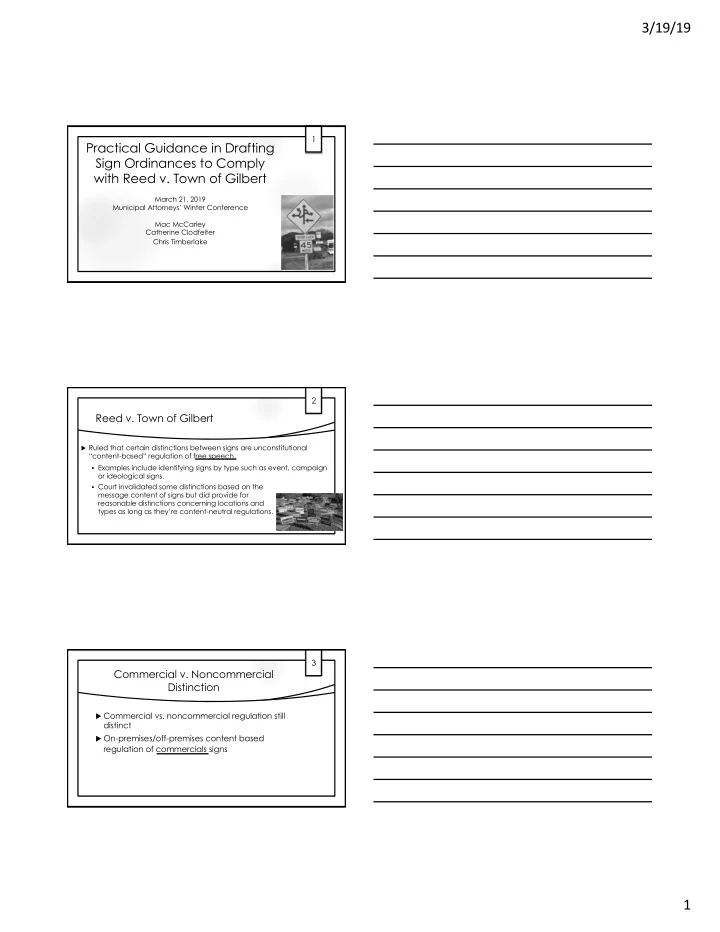

3/19/19 1 Practical Guidance in Drafting Sign Ordinances to Comply with Reed v. Town of Gilbert March 21, 2019 Municipal Attorneys’ Winter Conference Mac McCarley Catherine Clodfelter Chris Timberlake 2 Reed v. Town of Gilbert u Ruled that certain distinctions between signs are unconstitutional “content-based” regulation of free speech. § Examples include identifying signs by type such as event, campaign or ideological signs. § Court invalidated some distinctions based on the message content of signs but did provide for reasonable distinctions concerning locations and types as long as they’re content-neutral regulations. 3 Commercial v. Noncommercial Distinction u Commercial vs. noncommercial regulation still distinct u On-premises/off-premises content based regulation of commercials signs 1
3/19/19 4 How to Update Ordinances: General Provisions. u Include a provision that says non-commercial copy may be substituted for commercial copy on any sign that is otherwise permitted. Regulations cannot favor commercial copy over non-commercial copy. 5 Updating Ordinances: Signs Not Requiring a Permit. u Consider consolidating and “tweaking” of existing provisions. u Some content-based signs are felt to be defensible because they offer safety and aid the public. u Delete provisions that define signs based on content 6 Updating ordinances: Signs Not Requiring a Permit. (Temporary) u Revise the regulations on temporary signs to separate them, as much as possible, from sign content. 2
3/19/19 7 Updating Ordinances: Prohibited Signs and Sign Locations. u Include other types of signs often prohibited in other regulations as well as specific prohibition on signs containing material that is obscene under State law. 8 Updating Ordinances: Surface Area Computations. u Modify language as to how to calculate area of irregular signs (circles/triangles). u New language, “largest square or rectangle” that contains the copy. L L H H H L 9 Tenant ID Sign Example Revisions u Old language : “One tenant identification sign is allowed per business in a multi-unit building” u New language : “One sign per entrance is allowed on a building that houses one or more non-residential uses” 3
3/19/19 10 Flags Example Revisions u Old language : “Flags of the United States, the State of North Carolina, local governments, and the official flag of the entity occupying the property are allowed on any non-residential property” u New language : “Up to four flags may be displayed on any non-residential property” 11 Restaurant Sign Example Revisions u Old language : “The following signs are allowed on property used as a restaurant with drive-through facilities: entrance and exit signs at all entrances and exits, monument or pole business identification sign as allowed in the applicable zoning district, menu board with two way communication capability” u New language : “restaurants with drive-through facilities are allowed two signs no larger than 2’ by 3’ at each driveway onto the property, one monument or pole sign as defined and allowed in the applicable zoning district, and one additional sign which may have two way communication capability” 12 Gas Station Sign Example Revisions u Old language : “gas stations, convenience stores and any other location lawfully allowed to sell gasoline and fuel products may have a fuel island canopy sign that identifies the store or fuel sold on the premises” u New language : “Any business lawfully allowed to sell gasoline or fuel products may have two fuel island canopy signs on a fuel island canopy, such signs to be no larger than one quarter of the area of the side of the canopy on which the sign appears” 4
3/19/19 13 On-Premises/Off-Premises u Arguably content based: A sign will be considered to be an on-premise sign if it meets the following requirements. u (a) Premise—The sign must be located on the same premises as the activity or property advertised. u (b) Purpose—The sign must have as its purpose (1) the identification of the activity, or its products or services, or (2) the sale or lease of the property on which the sign is located, rather than the purpose of general advertising. 14 On-Premises/Off-Premises Content neutral: A regulation that defines an off-premise sign as any sign within 500 feet of a building is content neutral. Alternative: Make content based on-premises/off- premises only apply to commercial messages 15 Murals u Regulate based on the physical characteristics of a Mural, not on the content: “any sign painted directly on a wall, roof, or fence.” Peterson v. Vill. of Downers Grove, 150 F. Supp. 3d 910, 919 (N.D. Ill. 2015) (content neutral) u ALL must be regulated in the same manner, regardless of content, to be content neutral u But what is the difference between art and advertising? Is it content?? 5
3/19/19 16 Questions? 6
Recommend
More recommend